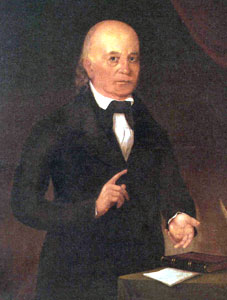
Gerard Troost
Gerard Troost, geologist, was born in s’Hertogenbosch, Netherlands, on March 5, 1776. As Tennessee state geologist (1831-50) and the state’s best known antebellum scientist, Troost promoted mining, planned transportation routes, described soils, and wrote forty-three geological reports. As he traveled the state searching for geological resources, Troost also studied botany, zoology, and archaeology, publishing pioneering work in these fields.
From his arrival in Tennessee in 1827 through 1832, Troost operated the Nashville Museum of Natural History, where he displayed his personal collection of zoological specimens, aboriginal artifacts, fossils, and minerals. His principal employment from 1828 through 1850 was the professorship of science at the University of Nashville. From 1840 through 1845, he coedited The Agriculturist, a monthly journal of applied science. Troost was a leader in the Nashville lyceum, in the mechanics institute movement, and in anything that involved libraries. He was obsessively bookish and owned a private library exceeding 7,000 volumes. As his death in 1850, his natural history collection contained some 22,000 specimens, including almost 14,000 well-catalogued minerals.
Troost lived a nomadic life before settling in Tennessee. His travels began in 1794-95, when French troops captured his home town and changed the name to Bois le Duc. Troost used both Gerard and Gerritt as his name, making it hard to distinguish his educational records. Clearly, he was an M.D., with a second diploma in pharmacy. He served as a foot soldier, then as a surgeon in the French-dominated Dutch army, and was wounded twice.
By 1802 Troost was making pharmaceuticals at The Hague, and he was also a well-known mineral collector. From 1807 to 1810 he was based at the natural history museum in Paris, managing the royal mineral collection of Louis Bonaparte, a French-imposed king of the Netherlands. Troost traveled widely, enhancing the royal collection. In Paris he was the protégé of Abbé René Just Haüy, the father of crystallography. In 1808 he translated Alexander von Humboldt’s Ansichten der Natur into Dutch. Eventually, Troost was competent in Latin, Greek, Dutch, German, French, and English.
In 1810, with the collapse of the Dutch monarchy eminent, Troost left France for Philadelphia. He claimed to be departing on a trip to reconnoiter Java for Louis Bonaparte, but he carried letters of introduction to American scientists. In 1811 Troost married Margaret Teague of Philadelphia. In 1811 or 1812 he joined a group that planned a chemical manufacturing business at Cape Sable, Maryland. It was one of America’s first chemical industries and an economic disaster; litigation surrounding the endeavor continued until the fall of 1828.
In 1812 Troost became the founding president of the Academy of Natural Sciences in Philadelphia, an office he held until 1818. Although he continued to attend Academy functions, Troost moved to Maryland by January 1814. Sometime later he returned to Philadelphia and served as one of two professors of pharmacy at the nation’s first pharmacy school, the Philadelphia College of Pharmacy. In the 1820s he lectured, managed the Academy mineral collection, and mapped the geology of Philadelphia. In addition, he worked on a revision of the first geological map of North America prepared by William Maclure and wrote fifteen papers for American journals.
Troost’s wife died in 1819, leaving him with two small children; he then married Mary O’Reilly, a widowed mother of two. By January 1826 the Troosts had settled in New Harmony, Indiana, the site of a communal experiment sponsored by the industrialist Robert Owen and William Maclure. Troost was hired at $500 per year to teach science and mathematics. Before the community declined in 1827, he lectured and wrote seven papers on regional geology.
While collecting minerals at Smithland, Kentucky, Troost met George Bowen, a friend from Philadelphia who taught chemistry at the University of Nashville. The Troost family soon relocated to Nashville and his personal letters brim with zeal for what he called his Tennessee Citizenship. Before becoming State Geologist, Troost provided many public services. For example, he contributed the idea for a railroad tunnel at Cowan and chose the site. In 1990-94, the tunnel still served twenty-seven to thirty trains per day, an enduring donation to all Tennesseans. Though his salary of $250 to $500 per year barely covered the cost of travel and research, clearly Troost enjoyed the labor from which so many Tennesseans have benefited and after years of wandering made the state his home.
Suggested Reading
James X. Corgan, ed., The Geological Sciences in the Antebellum South (1982)



